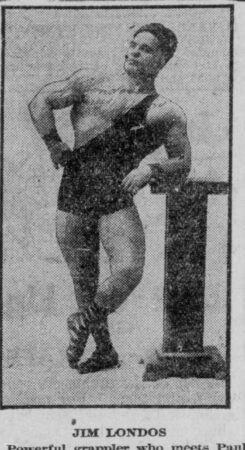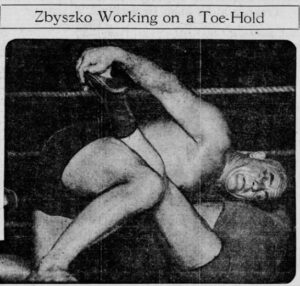Londos Outlasts Champion
On Friday, February 17, 1922, World Heavyweight Wrestling Champion Stanislaus Zbyszko wrestled a handicap match against Francois Lemarque and up-and-coming star Jim Londos. Londos was still a few years away from becoming the biggest box office draw in professional wrestling but he was the most popular wrestler in St. Louis.
While Londos only stood about 5’06” or 5’07”, he possessed a bodybuilder’s physique and a crowd-pleasing wrestling style. Londos would be considered a performer instead of shooter, a legitimate wrestler, or a hooker, skilled submission wrestler. However, Londos possessed enough wrestling ability that George Tragos wouldn’t let Lou Thesz wrestle Londos in the first year of Thesz’s career. Tragos feared Londos would attempt to injure Thesz, who Londos could see would be a future star.

Jim Londos from the November 16, 1920 edition of Idaho Statesman (Public Domain)
Zbyszko wasn’t defending his championship on this night. Zbyszko agreed to pin Lemarque and Londos in 75 minutes or be considered the loser. If Zbyszko failed to beat both men, it could set up a future championship match with one or both men.
Usually St. Louis wrestling matches were held at the Coliseum but this card occurred at the Odeon on Friday, February 17, 1922. Two matches preceded the main event.
Lemarque weighed about 180 pounds to Zbyszko’s 225 pounds. He didn’t provide much competition for the champion. Zbyszko proceeded at an easy pace, throwing and pinning Lemarque at 14 minutes, 52 seconds. John E. Wray, who wrote an article on the card for the St. Louis Post-Dispatch thought Zbyszko carried Lemarque that long as a courtesy.
Zbyszko left himself an hour to defeat Londos. Londos, who weighed 190 pounds, would be a much tougher opponent for the champion.
Londos wrestled defensively at first as the onus was on Zbyszko to pin him. At the 7 minute mark, Zbyszko secured a hold and went for a flying fall, which would end the match in New York. However, St. Louis officials didn’t recognize the flying fall rule, so the match continued.
Londos went on the offensive and secured a number of holds on Zbyszko. However, Zbyszko used his great strength to power out of all the holds. Both men started sweating profusely making Londos’ headlock attempts futile.

Stanislaus Zbyszko working the toe hold on Ed Strangler Lewis (Public Domain)
Close to the hour mark, Zbyszko secured a front facelock, which looked like it would secure the fall for the champion. After a couple minutes, Londos was able to escape the facelock. However, the escape left Londos vulnerable to a counter. Zbyszko grabbed a toe hold before Londos could regain his feet.
Zbyszko looked to be the victor as referee George Baptiste asked Londos if he would submit. Londos shook his head vigorously and powered out of the hold at the last minute.
Zbyszko grabbed a double wristlock, which Londos countered by bridging. Zbyszko tried to stop the bridge by leaning his weight onto Londos’ chest. Londos was strong enough to continue the bridge and escape the hold.
For the next five minutes, Londos took over on Zbyszko applying a succession of holds. Zbyszko wrestled defensively and escaped the holds but had no more offense left. Londos couldn’t pin Zbyszko to beat him decisively but he did win the match as the bell rang to end the match. Zbyszko failed to pin Londos, so Londos won the handicapped bout.
This result could have setup a match between Zbyszko and Londos for the title in St. Louis. These plans were scuttled, when Ed “Strangler” Lewis defeated Zbyszko to regain the title he lost to Zbyszko in May 1921.
Even though the matches were worked, Londos was scared of Lewis. Londos knew that if Lewis decided to shoot on him and make the match a legitimate contest, Londos would be unable to prevent Lewis from doing whatever he wanted. If Lewis wanted to embarrass Londos, Londos would be helpless to defend himself.
After Londos became a huge star, Lewis and Londos did work a few matches but only after Lewis put up a large cash forfeit, some said it was $25,000.00, to be given to Londos in the event of a double-cross. In 1922, Londos was not in a good bargaining position, so he wasn’t getting near Lewis.
You can leave a comment or ask a question about this or any post on my Facebook page or Twitter profile.
Sources: St. Louis Post-Dispatch, February 18, 1922 edition, p. 6 and Hooker by Lou Thesz

